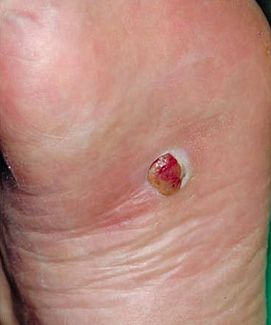Amelanotic Malignant Melanoma
The diagnosis in this case turned out to be a surprise: what are your suspicions?

A 47-year-old man presents with an estimated 6-month history of a slowly growing lesion on the plantar surface of the left foot. Other than oozing and crusting, the lesion is asymptomatic.
Key point: The two most common entities that present as exophytic, fleshy-appearing nodules on the foot are eccrine poroma and a clear cell acanthoma-both uncommon but totally benign tumors with distinct histologic characteristics. Surgical removal for these types of neoplasms is curative. When this lesion was removed, however, it unexpectedly proved to be an amelanotic malignant melanoma.
Treatment: Despite a second wide and deep excision and adjunctive biochemotherapy, regional nodal and then widespread metastatic disease developed. The latter proved to be fatal.
Note: Amelanotic melanoma is rarely diagnosed before biopsy/excision results are available because of the clinical lack of pigment. This routinely leads to a false sense of security and delay in diagnosis and therapy. Any body site may be affected with amelanotic melanoma.